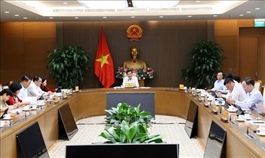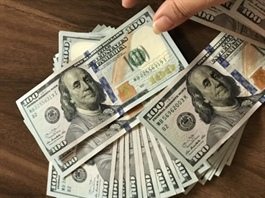Falling interest rates likely in H2
Falling interest rates likely in H2
On May 23, the SBV announced additional adjustments to a series of key interest rates, effective from May 25. This move marks the third round of reductions designed to boost the economy in less than three months. Interest rates are predicted to soften in the second half of the year, due to several factors in both the domestic and international markets.

Figures from the State Bank of Vietnam (SBV) show that as of May 9, the value of the whole economy was approximately $532 billion, up 2.7 per cent compared to the end of 2022 and up 9.6 per cent on-year.
After the SBV reduced the regulatory annual interest rate by a half of one per cent in late March, bank deposit rates fell by 0.2-0.5 per cent in April, with a further fall expected for May.
A senior executive at BIDV said that the SBV’s monetary policy is consistent with the 'loosening stance' expected to aid the economy as inflationary pressures cool significantly.
“It is likely that the SBV might further reduce the regulatory interest rates several more times from now until year-end to reaffirm lending rates after a softening streak and accompany the economy,” said the executive.
In addition, the mobilising-credit balance is forecast to further ameliorate with credit growth struggling to make a breakthrough, meanwhile mobilising is set to improve thanks to a fruitful forex supply.
In the first four months, Vietnam’s average inflation rate stood at 3.8 per cent compared to one year ago.
Tran Thi Khanh Hien, head of research at Hanoi-based securities firm VNDirect, noted that in its latest meeting, the US Federal Reserve announced its 10th interest rate hike by a quarter of a percentage point as part of its plan to operate between 5-5.25 per cent, as per market expectations.
This has been deemed a positive move, as the Fed did not suggest further rate increases beyond this. Instead, its decision would be based on forthcoming macro figures.
“This suggests that the cycle of interest rate increases will soon end. The market expects the Fed to temporarily pause the interest rates in its upcoming June meeting, and start to cut rates in the second half of this year as the US economy faces the growing danger of falling into recession,” said Hien.
An analytic expert at a Hanoi-based securities firm said, “Capital sources are abundant, but fewer people are taking on margin loans, pushing securities firms to reduce interest rates. Formerly, such rates touched 13-14 per cent, and they are now hovering around 11-12 per cent per year."
Amid faded exchange rate pressure, the SBV supplemented the forex reserve by around $6 billion in the first four months of the year, raising it to around $93 billion in an attempt to support banking system liquidity and rate reductions.
In that same period, Vietnam’s average inflation rate stood at 3.8 per cent compared to one year ago. The rate dropped to a 12-month low of 2.81 per cent in April from 3.35 per cent in the previous month, amid declines in component rates.
Of note, Vietnam Electricity's prices increased by 3 per cent in early May, which was lower than the proposed level of a 5-7 per cent hike in the retail price of power, reducing the overall impact of inflation.
“Inflationary pressure is cooling in the second quarter this year, matching the expectation that the average inflation rate will increase from 3.5-3.9 per cent on-year, and still below the ceiling rate of 4.5 per cent set by the National Assembly. This is an opportunity for the SBV to continue reducing the regulatory interest rate in the second half of the year,” said Hien.
“The government is accelerating public investment, pumping more money into the economy. We expect the average 12 month-term deposit interest rate of both public and private banks will fall by 50 basis points to 7 per cent in 2023.”






















